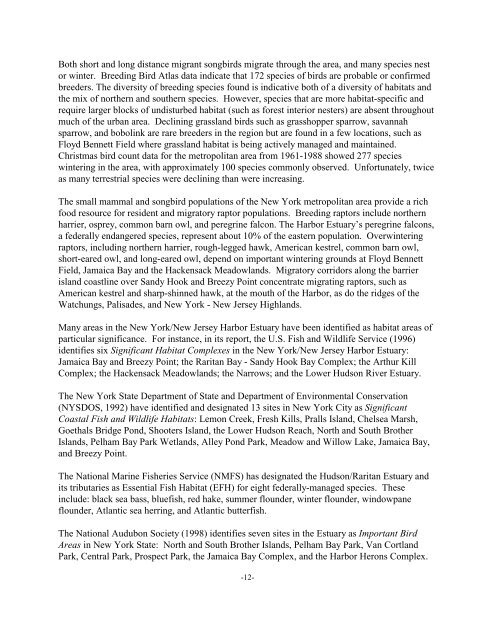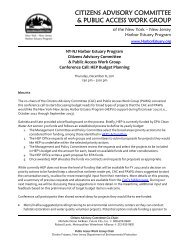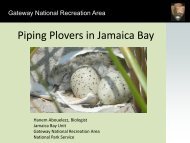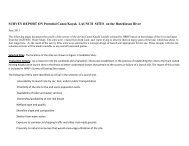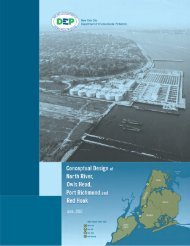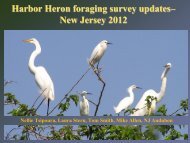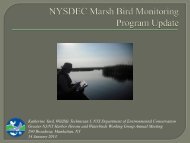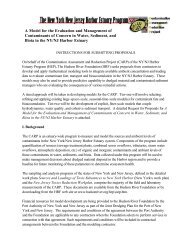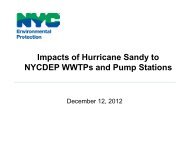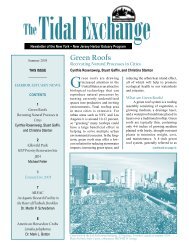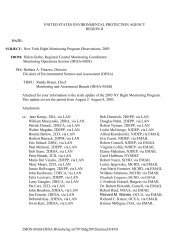DraftMitigation .pdf - New York-New Jersey Harbor Estuary Program
DraftMitigation .pdf - New York-New Jersey Harbor Estuary Program
DraftMitigation .pdf - New York-New Jersey Harbor Estuary Program
You also want an ePaper? Increase the reach of your titles
YUMPU automatically turns print PDFs into web optimized ePapers that Google loves.
Both short and long distance migrant songbirds migrate through the area, and many species nest<br />
or winter. Breeding Bird Atlas data indicate that 172 species of birds are probable or confirmed<br />
breeders. The diversity of breeding species found is indicative both of a diversity of habitats and<br />
the mix of northern and southern species. However, species that are more habitat-specific and<br />
require larger blocks of undisturbed habitat (such as forest interior nesters) are absent throughout<br />
much of the urban area. Declining grassland birds such as grasshopper sparrow, savannah<br />
sparrow, and bobolink are rare breeders in the region but are found in a few locations, such as<br />
Floyd Bennett Field where grassland habitat is being actively managed and maintained.<br />
Christmas bird count data for the metropolitan area from 1961-1988 showed 277 species<br />
wintering in the area, with approximately 100 species commonly observed. Unfortunately, twice<br />
as many terrestrial species were declining than were increasing.<br />
The small mammal and songbird populations of the <strong>New</strong> <strong>York</strong> metropolitan area provide a rich<br />
food resource for resident and migratory raptor populations. Breeding raptors include northern<br />
harrier, osprey, common barn owl, and peregrine falcon. The <strong>Harbor</strong> <strong>Estuary</strong>’s peregrine falcons,<br />
a federally endangered species, represent about 10% of the eastern population. Overwintering<br />
raptors, including northern harrier, rough-legged hawk, American kestrel, common barn owl,<br />
short-eared owl, and long-eared owl, depend on important wintering grounds at Floyd Bennett<br />
Field, Jamaica Bay and the Hackensack Meadowlands. Migratory corridors along the barrier<br />
island coastline over Sandy Hook and Breezy Point concentrate migrating raptors, such as<br />
American kestrel and sharp-shinned hawk, at the mouth of the <strong>Harbor</strong>, as do the ridges of the<br />
Watchungs, Palisades, and <strong>New</strong> <strong>York</strong> - <strong>New</strong> <strong>Jersey</strong> Highlands.<br />
Many areas in the <strong>New</strong> <strong>York</strong>/<strong>New</strong> <strong>Jersey</strong> <strong>Harbor</strong> <strong>Estuary</strong> have been identified as habitat areas of<br />
particular significance. For instance, in its report, the U.S. Fish and Wildlife Service (1996)<br />
identifies six Significant Habitat Complexes in the <strong>New</strong> <strong>York</strong>/<strong>New</strong> <strong>Jersey</strong> <strong>Harbor</strong> <strong>Estuary</strong>:<br />
Jamaica Bay and Breezy Point; the Raritan Bay - Sandy Hook Bay Complex; the Arthur Kill<br />
Complex; the Hackensack Meadowlands; the Narrows; and the Lower Hudson River <strong>Estuary</strong>.<br />
The <strong>New</strong> <strong>York</strong> State Department of State and Department of Environmental Conservation<br />
(NYSDOS, 1992) have identified and designated 13 sites in <strong>New</strong> <strong>York</strong> City as Significant<br />
Coastal Fish and Wildlife Habitats: Lemon Creek, Fresh Kills, Pralls Island, Chelsea Marsh,<br />
Goethals Bridge Pond, Shooters Island, the Lower Hudson Reach, North and South Brother<br />
Islands, Pelham Bay Park Wetlands, Alley Pond Park, Meadow and Willow Lake, Jamaica Bay,<br />
and Breezy Point.<br />
The National Marine Fisheries Service (NMFS) has designated the Hudson/Raritan <strong>Estuary</strong> and<br />
its tributaries as Essential Fish Habitat (EFH) for eight federally-managed species. These<br />
include: black sea bass, bluefish, red hake, summer flounder, winter flounder, windowpane<br />
flounder, Atlantic sea herring, and Atlantic butterfish.<br />
The National Audubon Society (1998) identifies seven sites in the <strong>Estuary</strong> as Important Bird<br />
Areas in <strong>New</strong> <strong>York</strong> State: North and South Brother Islands, Pelham Bay Park, Van Cortland<br />
Park, Central Park, Prospect Park, the Jamaica Bay Complex, and the <strong>Harbor</strong> Herons Complex.<br />
-12-


